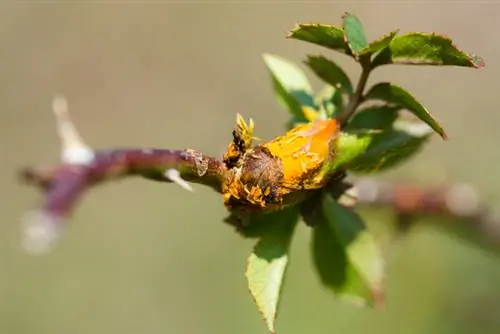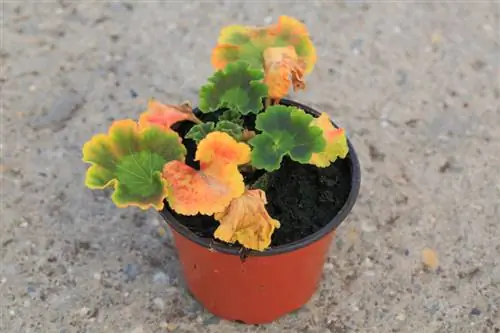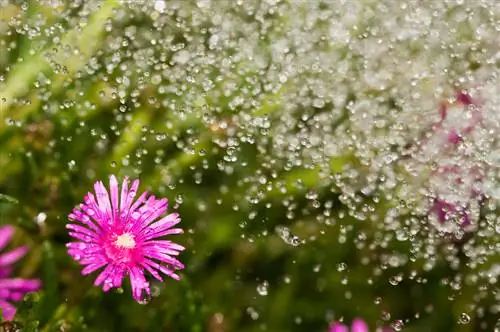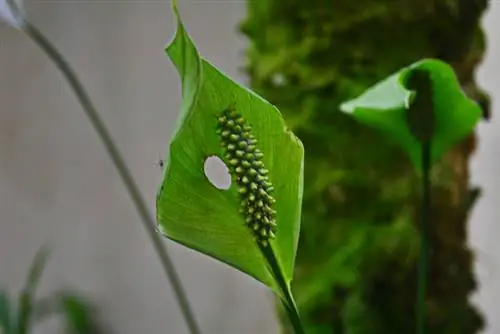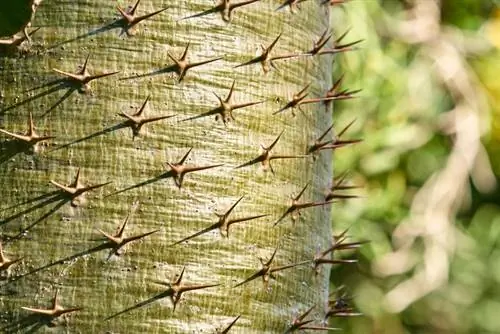- Author admin [email protected].
- Public 2023-12-16 16:46.
- Last modified 2025-01-23 11:20.
Roses have had the image of sensitive divas for a very long time, although this is no longer true with modern breeds. Many new varieties are very insensitive to the well-known rose diseases, but of course not completely immune to them. You can further strengthen the plants' natural resistance by ensuring a suitable location and good care. The choice of variety is just as important: roses with the so-called ADR seal are proven to be particularly robust and long-lasting.
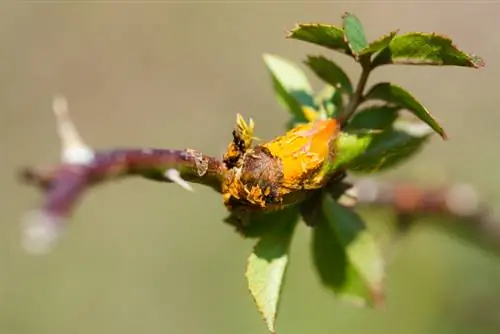
What rose diseases are there and how do you fight them?
Rose diseases such as chlorosis, powdery mildew, downy mildew, bark blight, rose rust, star sooty mildew and ring spot can be caused by fungi or nutrient deficiencies. Countermeasures include fungal control, balanced fertilization, plant strengthening and selection of resistant varieties.
Overview of harmful images and antidotes
If you notice any abnormalities on the leaves, trunk, shoots or flowers, it is important to act as quickly as possible. With timely intervention by the gardener, many infections can be easily contained right from the start, so that there is no risk of lasting damage to the plants. For this reason, you should regularly check your roses for possible damage and react appropriately if the disease occurs. To make this easier for you, we have briefly and succinctly described the common rose diseases.
Chlorosis
Chlorosis occurs primarily in spring, when the rose petals are pale yellow and only the leaf veins initially remain green. In addition, the rose grows poorly and only develops a few flowers. In most cases the cause is an iron deficiency, i.e. H. when the absorption of the important nutrient from the soil is hindered. This can be done, for example, by liming the roses. Less commonly, a lack of nitrogen (due to incorrect or insufficient fertilization), waterlogging or frost damage to the wood cause the symptoms. Chlorosis can be eliminated by spraying iron or foliar fertilizer and fertilizing the plants with seasoned compost, horn shavings or manure. Prevent chlorosis by aerating the soil well through regular loosening, fertilizing the roses in a balanced manner and also watering them when it is dry.
Powdery mildew
The powdery mildew on roses is caused by the fungus Sphaerotheca pannosa var.rosae and occurs primarily in warm, humid weather when the rose petals no longer dry quickly. A white, mealy and easily wiped off coating can be seen on the surface of leaves, shoots and buds; the leaves are also reddish in color and deformed. The affected damaged areas still continue to grow, but only at a meager pace; Buds don't open at all. Powdery mildew can be combated quite reliably with an old home remedy: spray whole milk diluted with water (ratio 1:10) several times every few days. You can also prevent this fungal disease by choosing resistant varieties, fertilizing the roses in a balanced manner and also ensuring that the location is airy. In spring the plants should be cut back heavily.
Downy mildew
The harmful fungus Peronospora sparsa causes the so-called downy mildew, which mainly occurs in late summer and autumn and as a result of strong temperature fluctuations. On the underside of the leaf there is a grayish-white patch of mold, while on the underside there are brownish to purple spots. These initially appear primarily on young leaves, but quickly spread. The affected leaves wilt and are eventually dropped. If you are infected with downy mildew, you should definitely collect and destroy all leaves; the soil can be disinfected with field horsetail broth. The disease can be prevented by placing the roses in an airy location, leaving enough space between the individual plants and thinning them out regularly.
Bark burn
Elongated, reddish-brown spots, especially around the eyes on previous year's, immature shoots, are not only an indication of possible frost damage, but can also be due to bark burn. This rose disease is also caused by a harmful fungus and can only be combated by severe pruning in spring. Spraying with green copper (available from specialist retailers), which should be carried out in winter, also helps. Prevent bark burn by fertilizing the roses in a balanced way, ensuring that the soil is aerated (loosening the soil) and supplying the plants with potassium magnesium in August.
Rose Rust
Rose rust, caused by the harmful fungus Phragmidium mucronatum, is one of the most common rose diseases. It mainly occurs in humid summers and shows itself as yellowish to reddish spots. Rusty red and dusty dots can be seen on the underside of the leaves, which turn black towards winter. This is the winter spore store from which the disease emerges again the following spring. Rose rust primarily affects roses on loamy and compacted soils, which is why loosening the soil and mixing in sand and compost (€41.00 on Amazon) is a good prevention. Affected leaves should definitely be collected and disposed of, while the rose can be strengthened by treating it with field horsetail broth.
Star sooty dew
Star sooty mold, which occurs primarily in late summer and is caused by the harmful fungus Diplocarpon rosae, is also one of the more common rose diseases. It initially appears as dark spots with star-shaped edges on the tops of the leaves; later the leaves turn yellow and fall off. Typically, the leaves growing close to the ground are affected first. Collect the infected leaves and disinfect the soil with field horsetail broth. It also helps to put garlic cloves in the ground or plant garlic around the rose. To prevent this, choose resistant varieties and plant them in an airy location. Be sure to adhere to the recommended planting distances and avoid over-fertilization with nitrogen.
Ring spot disease
The ring spot disease caused by the harmful fungus Sphaceloma rosarum occurs primarily in midsummer and on densely leafy varieties. Warm, humid weather promotes the development of the disease. Typically, the center of the round, reddish spots on the top of the leaf dies off, leaving behind a gray edge with a black edge. You can prevent this disease by ensuring that the stand is airy, giving strengthening agents (such as field horsetail broth) and removing affected leaves early.
Tip
Before using plant protection products, please seek extensive advice from a specialist retailer. When using, please strictly adhere to the recommendations given by the manufacturer, especially regarding dosage.

